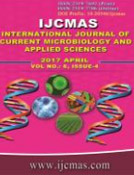


 National Academy of Agricultural Sciences (NAAS)
National Academy of Agricultural Sciences (NAAS)

|
PRINT ISSN : 2319-7692
Online ISSN : 2319-7706 Issues : 12 per year Publisher : Excellent Publishers Email : editorijcmas@gmail.com / submit@ijcmas.com Editor-in-chief: Dr.M.Prakash Index Copernicus ICV 2018: 95.39 NAAS RATING 2020: 5.38 |
A field experiment was conducted at Agricultural Research Station, Annigeri, University of Agricultural Sciences, Dharwad during rabi season of 2015-16 under rainfed condition to study the effect of integrated nutrient management (INM) practices on growth, yield and oil yield on safflower. Results revealed that all integrated nutrient management (INM) practices significantly influenced the growth and yield of safflower. Among the different INM combinations tested, application of RDF (40:40:12 kg ha-1 NPK) + 2.0 t ha-1 Vermicompost + Azospirillum + PSB + ZnSO4@ 10.0 kg ha-1 (T10) recorded significantly highest plant height (75.14 cm), Capsules (28.27 plant-1), Seed weight (21.45 plant-1), seed yield (989 kg ha-1), Oil content (28.65 %) and oil yield (283.32 kg ha-1). However, T7 (50 % RDF + 1.0 t ha-1 Vermicompost + Azospirillum + PSB + ZnSO4@ 10.0 kg ha-1) recorded significantly the highest net returns (Rs. 9,853 ha-1) and B:C ratio (1.61). This study indicated that despite drought year, integrated nutrient management (INM) practices helped in improving the seed and oil yield of safflower. Thus, such study needs to be continued to see the long-term effect on crop performance and resilience to climatic variability.
 |
 |
 |
 |
 |